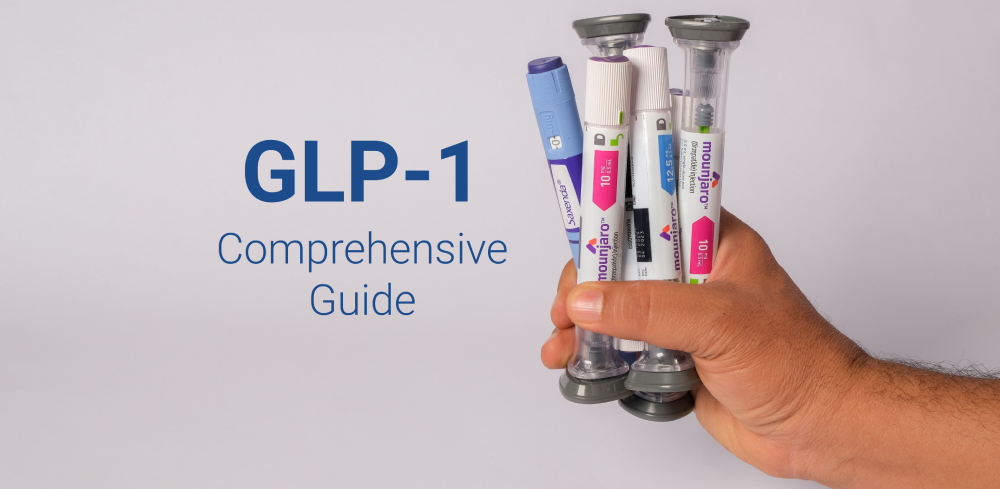A Historical Perspective on GLP-1 Treatments
The journey of GLP-1 (glucagon-like peptide-1) treatments began in the 1990s when researchers discovered the potential of this hormone in regulating blood sugar levels. Initially, studies focused on its effects in diabetes management, identifying GLP-1 as a key player in enhancing insulin secretion and decreasing glucagon production in response to high glucose levels. This was a pivotal moment, as it set the stage for the development of GLP-1 receptor agonists, which mimic the action of GLP-1 in the body.
In 2005, the first GLP-1 receptor agonist, exenatide (Byetta), was approved by the U.S. Food and Drug Administration (FDA) for the treatment of type 2 diabetes. This milestone marked the beginning of a new era in diabetes care, offering patients a new option that not only helped manage blood glucose levels but also promoted weight loss—a significant benefit, considering the obesity epidemic closely intertwined with diabetes. Subsequently, more GLP-1 receptor agonists emerged in the market, such as liraglutide (Victoza) and later semaglutide (Ozempic), with each iteration demonstrating improvements in efficacy and patient adherence.
Research advancements continued to unveil the multifaceted benefits of GLP-1 treatments, including cardiovascular protections, which enhanced their appeal in clinical practice. As a result, healthcare providers began to recognize GLP-1 drugs not merely as diabetes therapies but also as holistic options in the management of patients with metabolic syndrome. By the late 2010s, clinical trials further explored the potential of GLP-1 receptor agonists in addressing obesity, leading to a significant shift in their application.
This historical context illustrates how GLP-1 therapies evolved from niche diabetes drugs to essential components in obesity management. Understanding these developments is critical for investors keen on the pharmaceutical landscape, as it lays a foundation for comprehending the growing market share and success of companies specializing in GLP-1 treatments.

Novo Nordisk’s Market Performance and Growth Surge
Novo Nordisk has exhibited remarkable market performance over the past five years, largely propelled by the success of its GLP-1 receptor agonist, semaglutide, marketed under various brand names such as Ozempic and Wegovy. The company’s stock price has seen substantial growth during this period, reflecting its robust market strategies and innovative treatment offerings. In 2018, Novo Nordisk’s stock was valued at approximately DKK 300, but as of late 2023, it has surged to over DKK 900, representing a significant return on investment for early shareholders.
Revenue growth has similarly echoed the company’s stock performance. Novo Nordisk reported a revenue of DKK 93.9 billion in 2018, a figure that has soared to around DKK 196 billion in 2023, largely due to increased demand for its GLP-1 products. This astounding growth rate showcases the growing acceptance of GLP-1 therapies among healthcare professionals and patients alike, highlighting the importance of these treatments in managing conditions such as obesity and diabetes.
Furthermore, when comparing Novo Nordisk’s market capitalization to GDP figures, the company’s prominence becomes even more pronounced. With a market cap exceeding DKK 1 trillion, Novo Nordisk stands among the top pharmaceutical companies globally, reflecting its critical role in the healthcare sector. This valuation not only emphasizes the company’s market strength but also suggests future growth potential as the demand for GLP-1 treatments continues to rise.
Investors have benefitted significantly from Novo Nordisk’s growth trajectory, capitalizing on its pioneering role in the pharmaceutical industry. As the company continues to innovate and expand its offerings, the prospects for stakeholders remain positive, making Novo Nordisk a noteworthy player in the market.

Investor Perspectives: Early Buyers vs. Aspirants
The success of Novo Nordisk, particularly through its innovations in GLP-1 treatments, has created a disparity among investors, starkly contrasting the experiences of early buyers with those who entered the market later. For those who recognized the potential of GLP-1 therapies and invested in Novo Nordisk stock prior to its significant price surge, the rewards have been substantial. These investors, having capitalized on the early adoption of pioneering diabetes and obesity medications, generally view their decisions with satisfaction. Their strategies often included extensive research into market trends and understanding the long-term implications of innovative pharmaceuticals like GLP-1 on global health and wellness.
In contrast, latecomers who missed the initial investment wave often express sentiments of regret. This group typically consists of individuals who became aware of Novo Nordisk’s potential only after the stock had significantly appreciated in value, fueled by escalating interest in GLP-1 products. The fear of missing out (FOMO) becomes a driving force for these aspirant investors as they attempt to navigate the market and consider whether to invest now at a higher price point. Their challenge lies not only in assessing current valuations but also in predicting how the momentum of GLP-1 treatments will unfold moving forward.
As such, the contrasting experiences of these two groups present significant insights for investors. The early adopters teach valuable lessons regarding the importance of acting decisively when potential breakthroughs in pharmaceuticals emerge. Conversely, latecomers must apply a more analytical approach, weighing their options and cautiously evaluating how future developments in GLP-1 treatments could influence stock performance. Ultimately, the experiences of both investor segments underscore the necessity for continual monitoring of biotechnology trends and the emerging capabilities of pharmaceutical products in shaping future investment outcomes.

The Future of GLP-1 Treatments and Market Opportunities
The landscape of GLP-1 treatments is rapidly evolving, driven by ongoing research and a surge in product development. These medications, primarily known for their efficacy in managing type 2 diabetes and obesity, are witnessing an expansion in their therapeutic applications. Researchers are exploring the potential of GLP-1 receptor agonists beyond glycemic control, particularly in cardiovascular health, neurodegenerative diseases, and metabolic disorders. This broadened scope not only enhances the therapeutic utility of GLP-1 treatments but also opens new avenues for market growth and investor opportunities.
Recent studies indicate that incorporating GLP-1 drugs into the treatment regimens for various conditions can lead to improved patient outcomes. As healthcare providers include these medications in broader treatment methodologies, there is potential for significant market expansion. According to industry forecasts, the global GLP-1 market is expected to see a compound annual growth rate (CAGR) that could exceed 10% over the next five years, reflecting rising demand and the introduction of novel therapies.
However, the journey forward is not without challenges. Regulatory hurdles, cost implications, and the need for extensive clinical trials weigh heavily on the industry. Companies like Novo Nordisk are proactively addressing these concerns by investing in research and forming strategic partnerships that enhance their innovation capacity. By striving to ensure a steady pipeline of new treatments and maintaining rigorous clinical standards, these firms can effectively navigate the complexities of the pharmaceutical landscape. Additionally, focusing on real-world evidence can further support the case for GLP-1 treatments by demonstrating their benefits in various patient populations.
As the potential of GLP-1 drugs continues to unfold, investors should remain vigilant, closely monitoring advancements and market trends. The ability to leverage both existing and emerging GLP-1 therapies will be pivotal for companies aiming to secure a competitive advantage in a dynamic healthcare marketplace.


